There’s a tremor in the Force and the streaming series ‘Ahsoka’ on Disney+ is at the heart if it. Numerous opinions swirl around on social media, and it’s hard to make any sense of the conflicting accounts. Is ‘Ahsoka’ good or bad? I’ve been a vocal critic of the Ahsoka series, particularly the first two episodes. However, the show has steadily improved, and episode 5 turned my long-standing frustrations into real optimism. I’ll explore this episode, called ‘Shadow Warrior,’ and hopefully, I can break through the fog and explain what went right here…
***** WARNING: FULL SPOILERS AHEAD *****
Anakin Skywalker, reprised by Hayden Christensen, appears in the show and has been dismissed as merely a figment of Ahsoka’s imagination. I firmly believe this is false. The cosmic environment where Anakin meets Ahsoka is called the World Between Worlds. It’s a real place in Star Wars canon, an interdimensional reality where the past, present, and future coexist. The past and future can be changed here. This meeting is the first ever between the fallen Jedi, Anakin Skywalker, and his loyal Padawan after the events of Return of the Jedi. The two have a deep history that spans seven seasons of the Animated hit series, The Clone Wars, and forms one of the great duos in all of Star Wars.
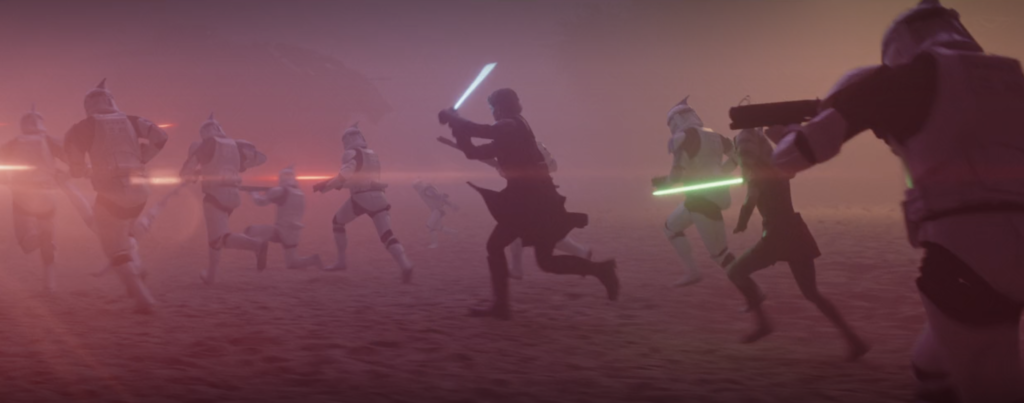
When Ahsoka fell from the cliff in episode 4, Anakin pulled her away from certain death and into the World Between Worlds. He’s really there in some form. She’s really there. That’s why Jacen can feel them in the Force even though Chopper can’t pick anything up on his scanner. That’s why Ahsoka is missing in the real world, where she fell. She isn’t dreaming.
While in the World Between Worlds, Anakin offers to finish Ahsoka’s training, which she accepts, even referring to him once again as “Master.”
The lesson is either “live or die,” relevant, considering Ahsoka just lost her fight with Baylan Skoll. She would be dead if not for Anakin pulling her into the World Between Worlds. So, choosing to live or die is the issue at hand for Ahsoka.
Anakin begins the lesson.
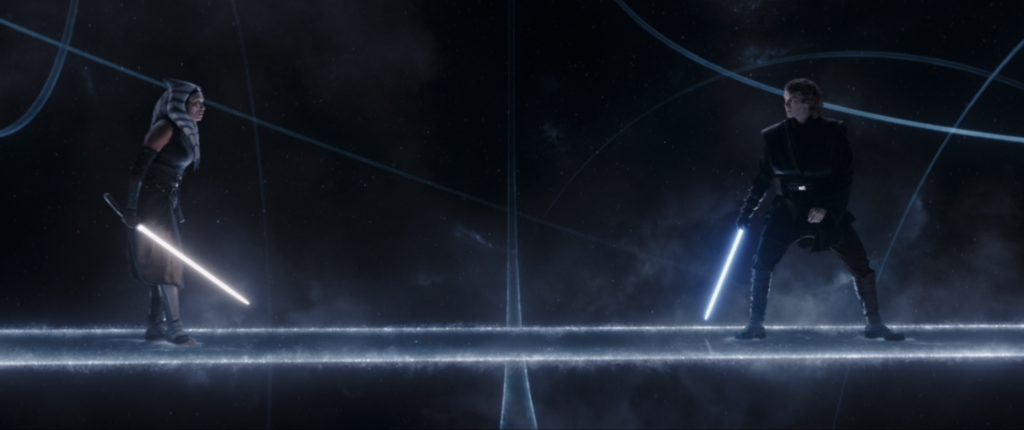
When Ahsoka declares, “I will not fight you,” Anakin eerily responds, “I’ve heard that before.” This line is an unmistakable call-back to Return of the Jedi when Luke Skywalker attempted this same strategy with Darth Vader. Ahsoka cannot know what Luke said to Vader in that final fight, so a figment of her imagination could not know that either. No. Only Anakin Skywalker knows that. And, as Vader did to Luke, Anakin presses Ahsoka into a deadly duel.
Folks, this is something we’ve never seen before if we stop to think about it. We see the continuation, at least in some form, of the only person who ever mastered the Good and the Dark Side of the Force. Obi-Wan, Yoda, and Qui-Gon could only teach their Padawans the Good side of the Force and warn against the Dark Side. Likewise, Palpatine could only teach the Dark Side. Never have we seen potent knowledge of light and dark in one mentor.
After the lightsaber battle lesson, Anakin sends Ahsoka falling into a vast liminal space. We see a younger Ahsoka, a girl, rise from the hazy mists into the dream world of her past. Clone troopers soon rush from out of the fog, having no beginning and no end, racing past Ahsoka only in the present moment, toward the unseen front line of a hazy battle in a doomed war.
We have returned to the symbolic Fall of humanity on a Galactic scale, the death of the Republic hangs in the air, and for the first time ever, we’re looking at these epic events through the eyes of an innocent. Ahsoka Tano inhabits the memory of her younger self with knowledge of the outcome. Jarred from her shock, young Ahsoka reluctantly follows the simple and seemingly hopeless command from Anakin, “Forward!” She lights her green lightsaber and advances into the void of nothingness.
The mentor and the pupil soon stand in the wake of battle amidst many fallen clones. Without a single spoken word, Ahsoka sits beside a clone trooper so wounded his face is fully covered. He cannot see or stand. But when Ahsoka takes his hand in a show of undisguised compassion, the clone trooper reaches back. They hold hands. Ahsoka cares about these living beings that lay like debris all around her.

She confronts Anakin about the cost of war. Anakin asserts that he, too, is bothered by the terrible loss of life. “This isn’t what I trained for,” says Ahsoka, acknowledging the shifting focus of the Jedi Order. Anakin tells her that the value of fighting and leadership is simply a matter of adapting to the times. He imparts the fateful wisdom of the era. “Look, when Obi-Wan taught me, we were keepers of the peace,” he says. Ahsoka worries here about her legacy. Is she to train her Padawan to fight? Anakin says in order to survive, “you’re gonna have to learn to fight.” Then, Ahsoka asks a child’s innocent question. “What if I want to stop fighting?”
“Then you’ll die,” he says, echoing the flawed wisdom that led the Jedi Order into an abyss of warfare, chaos, and forgotten virtues. “Let’s go,” says Anakin, lighting his lightsaber.
More clones rush past Ahsoka. She stands upon the battlefield and watches as the compassionate and heroic Anakin Skywalker heads out toward the horizon, leading yet another wave of clones to yet another position somewhere beyond the haze, his blue lightsaber out at his side. Under the flashing explosions of war, Anakin’s shape shifts seamlessly into Darth Vader holding a red lightsaber instead. And then, when the flashing subsides, we again see Anakin—the silhouette of perhaps the most tragic archetype from our modern mythology, shrinking in the distance as he continues steadily, relentlessly toward his fate.
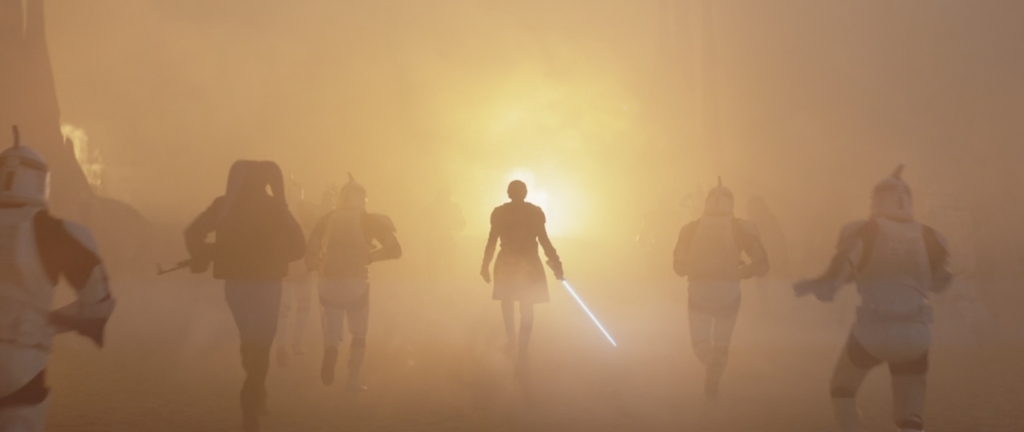
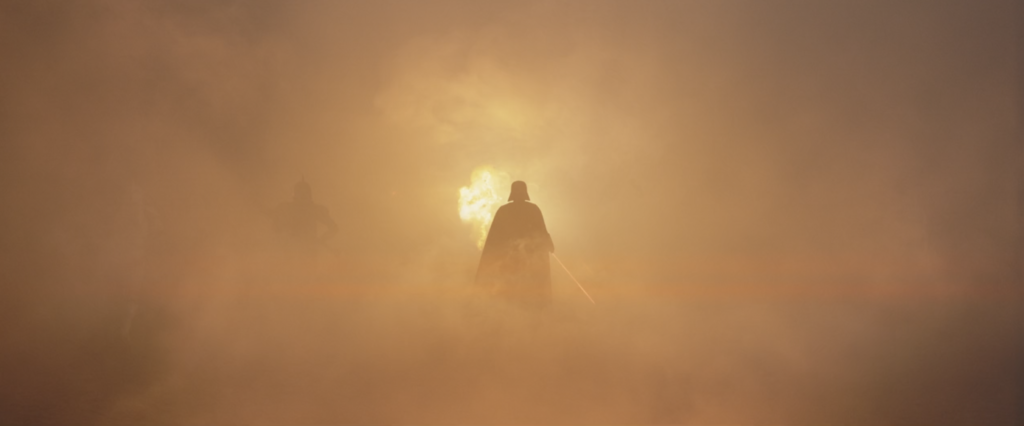
And centered in the dreamlike battlefield stands the young Ahsoka Tano. The music rises as the camera closes in on her face. She’s visibly scared, perhaps terrified by the inevitability of the course of events. She’s trapped in the memory of a failed pupil from a fallen master. This is stunning imagery that hits me hard. I’ve watched it multiple times, and I get more emotional with each viewing.
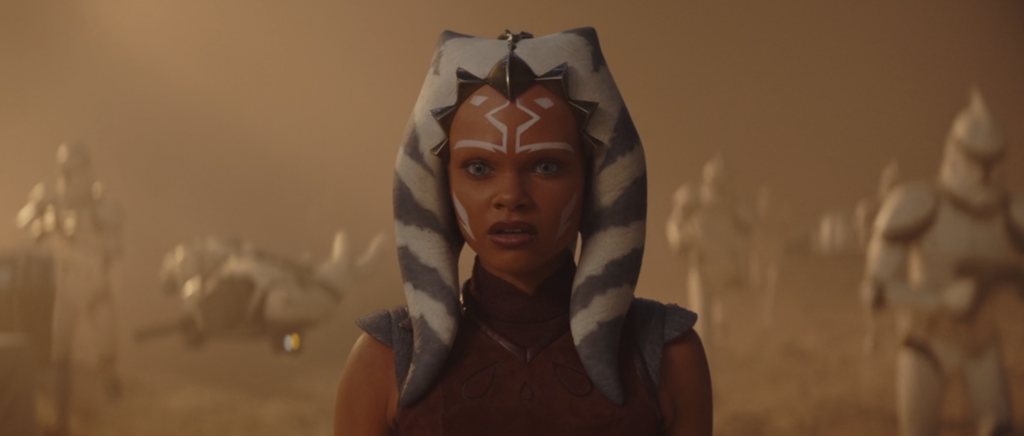
What is the answer to this disastrous fate? What could have stopped it?
We return to Anakin and Ahsoka, this time on Mandalore. And here, again, we see that she’s concerned about her legacy. This is the Sacred Fire of both the Jedi order and our heroine. What is her purpose? What is she supposed to pass on? Anakin tells her that she’s more than just a fighter, just as he was more than just a fighter.
“You are more, Anakin,” she says. “But more powerful and dangerous than anyone realized.” And here, Anakin grows cold and begins a new lesson, only this is a lesson from the Dark Side of the Force. Anakin says, “I gave you a choice. Live or die.”
Ahsoka remains defiant. “No,” she says.
Then, after a chilling pause, the dark lord of the Sith cocks his head, “Incorrect.” Dressed as Anakin, Darth Vader launches a brutal flurry of attacks with his red lightsaber before kicking Ahsoka off her feet.
The fight resumes in the World Between Worlds, where Ahsoka finally bests Anakin. The camera shows a close-up of her face as she holds Vader’s saber to his neck, her every impulse to kill him showing in her momentary yellow eyes.
“I choose to live,” she says decisively.
And she means it. Ahsoka had feared her legacy would be death and destruction, just as Baylan said in the last episode. But when she has the chance to kill Darth Vader, Ahsoka chooses life. Ahsoka the gray, the indecisive, the watcher from the side lines, the lukewarm…is ready to grow and face the coming evils with conviction again, her missing quality.
The lesson is complete.
Vader closes his yellow Sith eyes and collects himself. When he looks again upon Ahsoka, we see the compassionate mentor return, the redeemed Anakin Skywalker, smile, and say, “There’s hope for you yet.”
Episode 5 captures the powerful archetypal symbols and feelings of storytelling that used to define Star Wars. It’s all there. I haven’t really seen it a long while. The ethics of force, the central power of individual choice, discipline versus seduction, good versus evil, life versus death, mentor and pupil—these are the themes that fuel the engine of Star Wars.
The master of the Good and Dark side of the Force has arrived. That mentor is Anakin Skywalker.
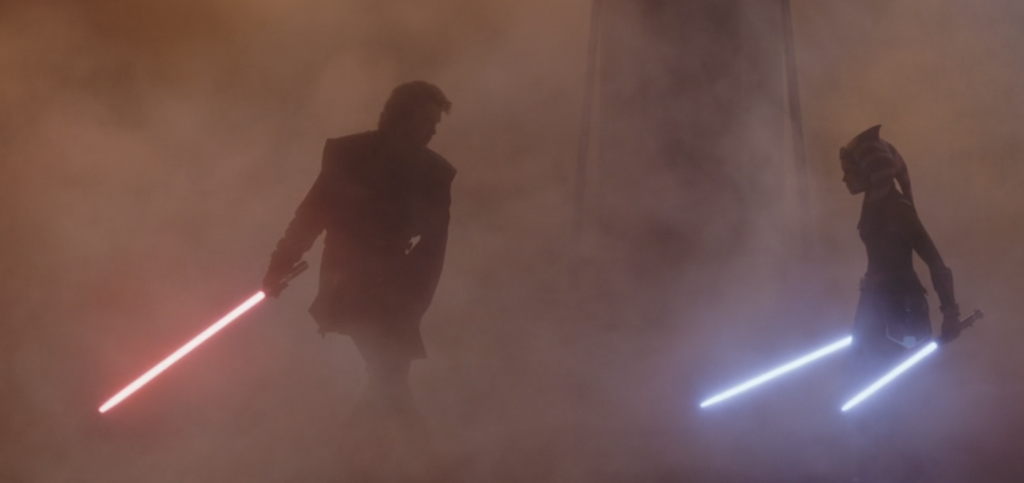
Ahsoka is then returned to the sea. She did not hold her breath all that time because she never hit the water when she fell. She was in the World Between Worlds, and Anakin has returned her intact, in the baptismal waters of change and renewal. When she awakens, she squints and mutters, “Anakin…”
WHY IS THIS IMPORTANT?
The Prequels ended in catastrophe and the loss of light in the galaxy. The original trilogy concluded with triumph over evil and the return of the Jedi. The question going forward is now what?
The rise of the New Republic means nothing without first facing the failures of the Galactic Republic from the prequels. The Jedi Order cannot return unless it changes. The new government will surely fail like the old one unless it changes. Now that the Empire has been defeated and the Jedi have returned, what do we do differently this time? What are the hard lessons from the catastrophe of Order 66 that caused the Empire to rise in the first place? And how do we learn to avoid that doom again going forward?
The sequel trilogy never answered these critical questions. Perhaps, the new regime at LucasFilm didn’t believe in Star Wars so much as they believed in their own hype.
And that is why they fail…
I believe there’s a plan here. I sense it. I don’t believe the sequel trilogy will be erased necessarily, not while the current regime is still in place at LucasFilm anyway. But I do believe that an alternate future is about to open up in the World Between Worlds, and Ahsoka will enter that future. Hopefully, the future of Star Wars will go with her.
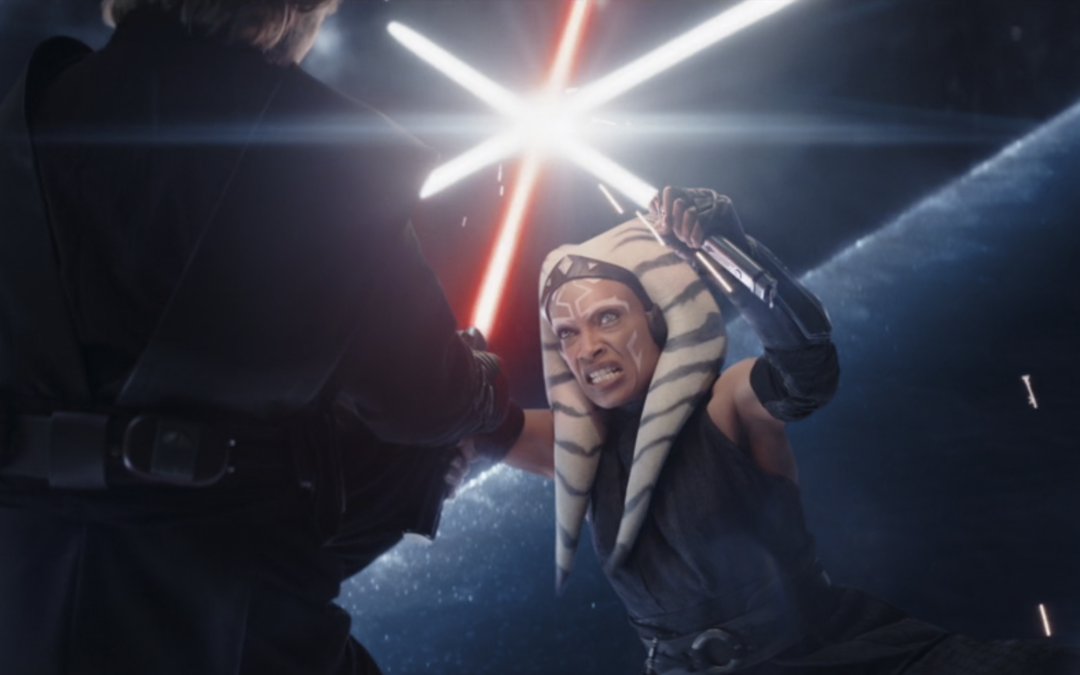
Thank you for your insight! I would like to believe that Ahsoka does bring on great future changes…:) Time will tell.
I met Ahsoka when a lot of people did, Clone Wars. I watched it with my son, but admittedly probably would have watched it if I didn’t have kids.
I was super excited to find out about the series and even more excited to see that Rosario Dawson was playing Ahsoka. Very cool… As a Jedi master, a male or female is a leader and it’s very cool they picked Ahsoka to make a series around.
She’s a great role model. She’s compassionate and powerful. Great combination!